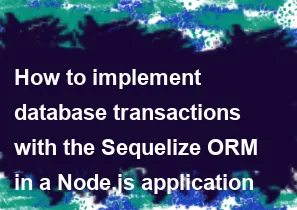How to implement database transactions with the Sequelize ORM in a Node.js application

Sequelize is a popular Object-Relational Mapping (ORM) library for Node.js that supports multiple database systems, including PostgreSQL, MySQL, SQLite, and MSSQL. Implementing database transactions with Sequelize involves managing multiple database operations as a single unit of work, ensuring that either all operations are successful or none are applied.
Here's a step-by-step guide on how to implement transactions with Sequelize in a Node.js application:
Install Sequelize:
Make sure you have Sequelize installed in your Node.js project. You can install it using npm:
bashnpm install sequelizeAlso, you'll need to install the database driver for the specific database you're using, for example:
bashnpm install pg # for PostgreSQLSet Up Sequelize:
Set up Sequelize in your Node.js application by creating a Sequelize instance and defining your models.
javascript// sequelize.js const { Sequelize } = require('sequelize'); const sequelize = new Sequelize('database', 'username', 'password', { dialect: 'mysql', // or 'postgres' | 'sqlite' | 'mssql' host: 'localhost', }); // Define your models here // const User = sequelize.define('User', { /* ... */ }); // ... module.exports = { sequelize };Use Transactions:
Wrap your database operations in a transaction using
sequelize.transaction()method.javascriptconst { sequelize } = require('./sequelize'); const performTransaction = async () => { try { await sequelize.transaction(async (t) => { // Your database operations go here // For example: // await User.create({ /* ... */ }, { transaction: t }); // await Post.create({ /* ... */ }, { transaction: t }); }); console.log('Transaction committed successfully'); } catch (error) { console.error('Transaction failed:', error); } }; performTransaction();Rollback and Commit:
Inside the transaction callback, you can decide to commit or rollback the transaction based on your application logic.
javascriptconst { sequelize } = require('./sequelize'); const performTransaction = async () => { const t = await sequelize.transaction(); try { // Your database operations go here // For example: // await User.create({ /* ... */ }, { transaction: t }); // await Post.create({ /* ... */ }, { transaction: t }); // If everything is successful, commit the transaction await t.commit(); console.log('Transaction committed successfully'); } catch (error) { // If an error occurs, rollback the transaction await t.rollback(); console.error('Transaction failed:', error); } }; performTransaction();This ensures that if any of the operations within the transaction fail, the entire transaction will be rolled back, maintaining the consistency of your database.
Remember to customize the code according to your actual Sequelize models and database operations.
-
Popular Post
- How to optimize for Google's About This Result feature for local businesses
- How to implement multi-language support in an Express.js application
- How to handle and optimize for changes in mobile search behavior
- How to handle CORS in a Node.js application
- How to use Vue.js with a UI framework (e.g., Vuetify, Element UI)
- How to configure Laravel Telescope for monitoring and profiling API requests
- How to create a command-line tool using the Commander.js library in Node.js
- How to implement code splitting in a React.js application
- How to use the AWS SDK for Node.js to interact with various AWS services
- How to use the Node.js Stream API for efficient data processing
- How to implement a cookie parser middleware in Node.js
- How to implement WebSockets for real-time communication in React
-
Latest Post
- How to implement a dynamic form with dynamic field styling based on user input in Next.js
- How to create a custom hook for handling user interactions with the browser's device motion in Next.js
- How to create a custom hook for handling user interactions with the browser's battery status in Next.js
- How to implement a dynamic form with dynamic field visibility based on user input in Next.js
- How to implement a dynamic form with real-time collaboration features in Next.js
- How to create a custom hook for handling user interactions with the browser's media devices in Next.js
- How to use the useSWRInfinite hook for paginating data with a custom loading indicator in Next.js
- How to create a custom hook for handling user interactions with the browser's network status in Next.js
- How to create a custom hook for handling user interactions with the browser's location in Next.js
- How to implement a dynamic form with multi-language support in Next.js
- How to create a custom hook for handling user interactions with the browser's ambient light sensor in Next.js
- How to use the useHover hook for creating interactive image zoom effects in Next.js